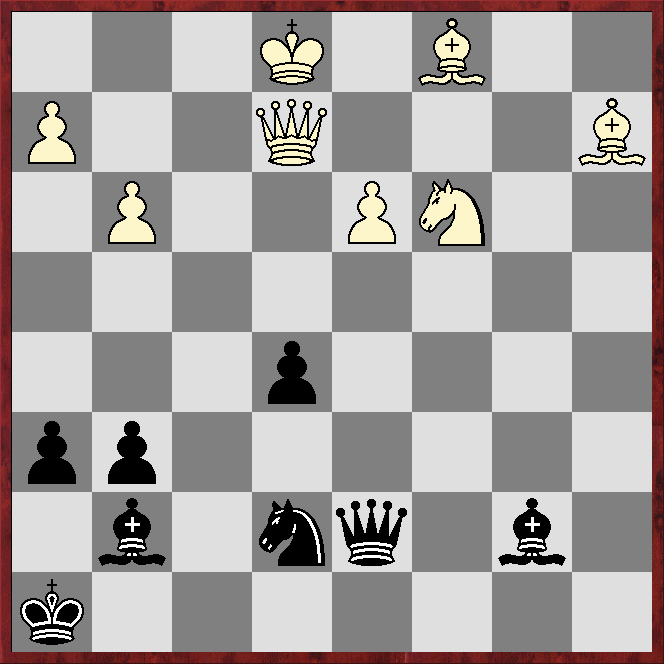Bob Wheat (1786) - Spanton (1954)
King's Indian Attack/Sicilian Closed
1.Nf3 c5 2.g3 Nc6 3.Bg2 g6 4.d3
 |
| At this point ChessBase calls the opening: "B25: Closed Sicilian: 3 g3, lines without early Be3" |
*****
*****
*****
*****
Black is certainly using a Sicilian-style setup, but without White playing 1.e4 it seems strange to refer to the opening as a Sicilian. White's move-order is typical of the King's Indian Attack, although a case could be made for calling the opening a Reversed Pirc.
4...Bg7 5.e4
Now a Sicilian classification seems much more appropriate.
5...d6 6.0-0 e5 7.Nc3 Nge7 8.Nh4!?
There are 184 examples of this move in ChessBase's 2025 Mega database, but more popular are 8.Be3 and especially 8.Nd2!?
8...0-0
*****
*****
*****
*****
Black has more space on the centre-queenside, but a hole at d5, although White's pieces are not well-placed to exploit the hole. Dragon1 gives Black a slight edge, but Stockfish17 is less sure.
9.Kh1!?
This is a typical move when planning to push the f pawn, but here it is far from clear the move is needed as Black cannot do much on the a7-g1 diagonal.
9...Nd4 10.f4
*****
*****
*****
*****
10...f5!?
The engines reckon best is 10...exf4 11.Bf4 (11.gxf4 f5) h6 12.Be3 g5 13.Nf3 Bg4, all of which was played in Kevin Sturm (1884) - René Dausch (2378), Einhausen Ried (Germany) 2010, when Black went on to win.
The text, which may be a novelty, is strongly disliked by the engines.
*****
*****
*****
*****
11.exf5
The engines reckon 11.fxe5 dxe5 12.Bg5 gives White at least a slight edge.
11...Nexf5 12.Nxf5 Nxf5 13.Bd5+ Kh8 14.Rb1 Rb8 15.a4 a6 16.Ne4?!
Eyeing the g5 square, with hopes of Nf7+, but there is a flaw.
*****
*****
*****
*****
16...h6
This is good enough for a slight edge, according to the engines, but they much prefer 16...Ne7, after which White's light-square bishop must retreat to the queenside, or allow itself to be exchanged - either way, the white king's position is weakened, and ...Bh3 is coming.
17.c3 b5 18.axb5 axb5 19.b4?!
Probably too ambitious. The engines suggest 19.Nf2, but much prefer Black.
19...Ne7 20.Ba2 Bb7 21.Kg1?!
Unpinning the knight, but hardly improving the safety of the king.
21...cxb4 22.Qe2!?
The engines give 22.cxb4 Qb6+ 23.Kg2 exf4 24.Bxf4 Qd4, but reckon Black is winning.
22...bxc3 23.fxe5 Rxf1+ 24.Kxf1!? dxe5 25.Rxb5 Qd7 26.Rc5 Rf8+ 27.Ke1!?
Probably safer is 27.Kg2, but the engines reckon Black's advantage is worth in the neighbourhood of a rook.
27...Rc8?!
This gives up a lot of Black's advantage, whereas 27...Nf5 or 27...Nc6 leaves Black winning easily, according to the engines.
*****
*****
*****
*****
28.Rxc3??
After 28.Rxc8+ Qxc8 29.Bc4 Black has only a slight edge (Stockfish17) or at best the upper hand (Dragon1).
As I made my reply, BW offered a draw.
28...Rxc3??
Missing the win of a piece by 28...Bxe4 29.Rxc8+ Qxc8, after which White cannot both capture on e4 and protect c1.
29.Nxc3
BW, again in my time, said his previous draw offer still stood.
*****
*****
*****
*****
Material is level, and both players have an isolated pawn. The engines reckon the game is equal, but I suspect most humans would look at the exposed white king and conclude that, even if chances really are equal, Black's position is easier to play.
29...Qc6 30.Bb2 Qh1+ 31.Kd2 Bf3 32.Qf2 h5
*****
*****
*****
*****
33.Kc2?
The engines reckon giving up a pawn by 33.Ne4!? Bxe4 34.dxe4 Qxe4 leaves Black with at best a slight edge, while 33.Ne2 is completely equal, and if 33...Bh6+, then 34.Kc2.
33...Nc6 34.Ba3?
This is the engines' second choice, but they reckon much better is 34.Kb3, albeit accepting that 34...Bd5+ gives a winning advantage, eg 35.Ka3 Bxa2+ 36.Nxa2 Qd5 37.Nc1 Bh6 38.Qb6 Bxc1 39.Bxc1 Qxd3+. If in this line White tries 36.Kxa2, then 36...Nb4+ and 37...Nxd3.
34...Nd4+ 35.Kb2 Bh6
White has no defence to the threat of ...Qc1+.
36.Bc4 Qc1+ 37.Ka2 Qxc3
The game finished:
38.Bb2 Qa5+ 39.Kb1 Qb4 40.Ka2 Qa4+ 41.Kb1 Qd1+ 42.Ka2 Qe2 43.Qg1 Bd2 44.Qb1 Bc3 0-1







No comments:
Post a Comment